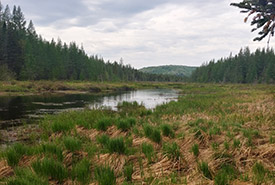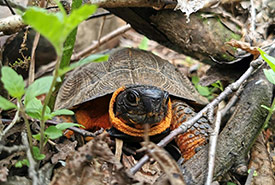Shawinigan and Saint-Mathieu-du-Parc: Rich environments protected thanks to 22 donors

Shawinigan, Qc (Photo by NCC)
Allies for biodiversity
Twenty-two people banded together to protect nature in Mauricie. The group organized an impressive fundraising campaign to raise the money needed to protect 271 hectares, almost doubling the area already protected! The $650,000 raised included financial contributions from public partners. In addition to this incredible commitment, some of them are now NCC’s conservation volunteers. The group will ensure the conservation of these environments, which are so close to their hearts. The wetlands, riparian and aquatic habitats and forest environments (including a mature maple grove) that make up the newly protected territory greatly enrich the area.
To succeed in preserving the most beautiful aspects of nature that we have is our greatest challenge. Conservation is everyone's business, and this project has been particularly unifying for the residents of our small community who are attached to this unique territory. A great sense of pride and accomplishment now drives us all, and we are ready to continue with this momentum. — Denis Trépanier, representative of the donors.
A vital natural corridor
The newly protected areas are located in the surrounding areas of La Mauricie Park, and now includes eight properties totalling over 570 hectares protected by the Nature Conservancy of Canada (NCC). Two of these are part of the Tortue-des-Bois-de-la-Shawinigan Nature Reserve. The proximity to other protected areas promotes ecological connectivity.
Ecological connectivity is defined as the degree of connection between the various natural environments present within the same landscape. Together, NCC's properties and La Mauricie Park form a corridor that allows animals to move safely and freely to feed and mate.
Road mortality is a major problem in the movement of wildlife, particularly turtles. This corridor will protect connected natural habitats so these reptiles can more easily reach the habitats that are essential to them, such as the main egg-laying site of wood turtles.
As very few wood turtles reach adulthood, road collisions can cause a significant decline in theirpopulation numbers. And this is why protection efforts in the Mauricie region are essential to the recovery of this species.
Essential efforts for wood turtles

Wood turtle (Photo by NCC)
Wood turtles, easily recognized by their orange throat and legs, is a species designated as threatened in Canada and vulnerable in Quebec. It is found in the areas newly protected by NCC.
Protecting wood turtle populations is essential to the overall health of ecosystems. These reptiles feed on plants, insects and dead animals, which helps keep wetlands healthy. With a life expectancy of over 50 years, wood turtles take their time to find the ideal place to lay their eggs, sometimes exploring a site for days before deciding.
If you see a turtle, dead or alive, NCC and the Carapace Project invite you to fill in the report form. This enable us to target habitats that are important for the species’ survival.
Other species
More than 80 bird species can be found in the newly conserved areas, including several at-risk species, such as bobolink (vulnerable in Quebec and threatened in Canada), Canada warbler (likely to be designated vulnerable or threatened in Quebec and threatened in Canada) and evening grosbeak (considered of special concern in Canada). Two plant species that are vulnerable in Quebec, crinkleroot and bloodroot, are also found here
Acknowledgements
The Nature Conservancy of Canada would like to thank our donors: Jacques Bois, Mathieu Duchaine and Charlotte Jolicoeur Desroches, Alain Grenier and Thérèse Delisle, Charles André Horth and Brigitte Lepage, the Jacob-Roy family, Jean-Hugues Langlois and Toby Stewart, Etienne Laplante-Courchesne, Martin Lapointe, Alan and Judith Renshaw, Denis Trépanier and Annie Jacques, Chantal Trépanier and four anonymous donors.






